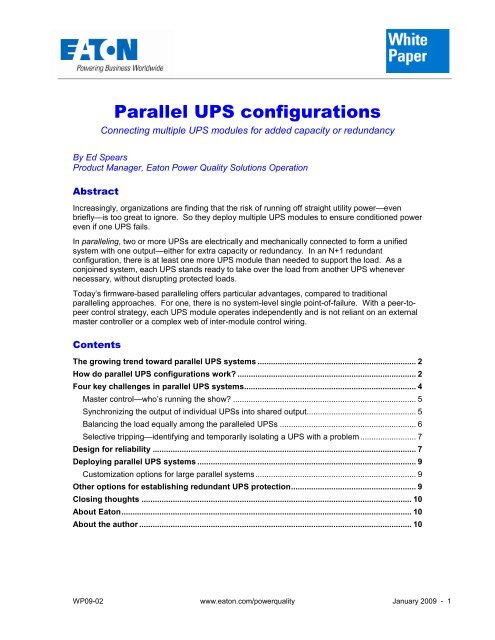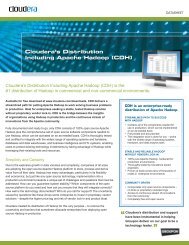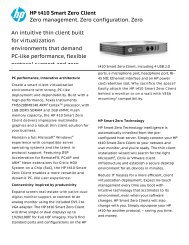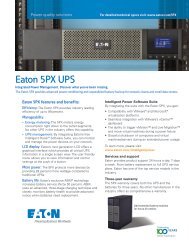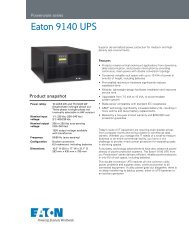Parallel UPS configurations - Eaton Corporation
Parallel UPS configurations - Eaton Corporation
Parallel UPS configurations - Eaton Corporation
You also want an ePaper? Increase the reach of your titles
YUMPU automatically turns print PDFs into web optimized ePapers that Google loves.
For example, you could protect an 800 kVA load by deploying three 400 kVA <strong>UPS</strong> modules.During normal operation, the three modules would each carry one-third of the total 800 kVA load.If one module went offline, the remaining two modules would have sufficient capacity to supportthe load.The diagram shows a typical parallel configuration with two three-phase <strong>UPS</strong> modules. In normaloperation, AC power flows from the utility source to each <strong>UPS</strong>—one input into the rectifier andone into an internal bypass. The <strong>UPS</strong> converts incoming AC power to DC and then back to AC,then sends this clean power to a tie cabinet, where outputs from both <strong>UPS</strong>s are merged into asingle output to protected loads.Figure 1.In normal parallel operation, both <strong>UPS</strong> modulescontribute equally to shared output.Should a failure of any kind occur with either module, the critical load is still <strong>UPS</strong>-protected.Internal diagnostics immediately isolate the faulty <strong>UPS</strong> module from the critical bus while theother <strong>UPS</strong> assumes the full load.Figure 2.If either <strong>UPS</strong> module becomes unavailable,the remaining module assumes the load.A parallel configuration is not limited to two <strong>UPS</strong> modules. It frequently includes up to fourmodules. With some newer <strong>UPS</strong>s, you can parallel as many as eight modules.WP09-02 www.eaton.com/powerquality January 2009 - 3
Figure 3.Up to eight <strong>UPS</strong> modules can be paralleled into a single system.During a utility failure, each <strong>UPS</strong> module is supported by its battery system and can continueoperating for minutes or hours, depending on how much battery runtime has been provisioned.You can (and should) provision separate battery backup for each <strong>UPS</strong>, for even greater backupprotection.The configuration shown in Figure 4 has a bypass cabinet rather than the standard tie cabinet.When many <strong>UPS</strong>s are linked in parallel, the load they collectively support could exceed thecapacity of the internal static switch and bypass circuit in any one <strong>UPS</strong>. The bypass cabinet, withits own static switch, provides an alternate route for power during a failure—an automatic andinstant wraparound bypass.Such an event would be rare. The wraparound bypass would be activated only if all three <strong>UPS</strong>swere unable to support the load. Perhaps a short circuit caused an extraordinary overload thatexceeded the capacity of all three modules together. The system would identify a failure on thecritical bus and transfer to bypass mode with virtually no interruption.Figure 4.Power flows to critical loads, even if all three modules were offline.Four key challenges in parallel <strong>UPS</strong> systemsAs soon as you connect multiple AC power sources into a unified, parallel system, there are fourkey challenges to address:• Controlling how the separate <strong>UPS</strong>s should cooperate as a unified system• Synchronizing the output of each <strong>UPS</strong> so it can flow into a shared output• Balancing the load equally among all <strong>UPS</strong>s in the parallel configuration• If trouble occurs, identifying and temporarily decommissioning the <strong>UPS</strong> with the problemThese issues can be complex, and they must be managed in a way that does not compromisethe high reliability for which <strong>UPS</strong>s are paralleled in the first place.WP09-02 www.eaton.com/powerquality January 2009 - 4
Selective tripping—identifying and temporarily isolating a <strong>UPS</strong> with a problemWhen <strong>UPS</strong> modules are paralleled, it can be difficult to identify the root cause of a failure. Youmight see a drop in voltage on the shared output bus, but which <strong>UPS</strong> is the culprit? You need tofind out which module is causing the problem, and isolate it quickly before it drags down othermodules and causes the whole system to switch to bypass mode.In a conventional parallel <strong>UPS</strong> configuration…A faulty module may be signified by the whole system going to bypass. Though most modulefailures are benign, a failed inverter IGBT or shorted capacitor may appear as a fault on thecritical bus. For this type of failure, it could be difficult to quickly identify the root cause andremove the failed module from the critical bus. The system could go to bypass, leaving loadsexposed to straight utility power for as long it takes for service to arrive.In a more resilient parallel <strong>UPS</strong> configuration…Each module need only look at itself to see if it has failed. An algorithm assesses thedifference in current/voltage in each phase and detects failures based on a running record ofthis information—continually comparing present waveforms with previously recordedwaveforms. Based on this high-speed calculation, the unit detects a fault even before typicalhardware sensors would detect it. The affected <strong>UPS</strong> module turns off its inverter IGBTtransistors within microseconds (millionths of a second). The result is a selective trip thatinstantly isolates the faulty unit from the system until the problem can be resolved.Since this process does not require communication links among modules, the module is swiftlyremoved from the critical bus before the problem can affect critical loads and before the systemsees the need to go to bypass.Design for reliabilityRedundant <strong>UPS</strong> <strong>configurations</strong> are a necessity to meet the uptime requirements of a 7/24world—and paralleling is a key way to maximize that uptime. However, when two or more ACpower sources are joined in parallel, you may solve one problem while potentially creating others,for all the reasons described earlier.Most parallel technologies on the market can adequately meet the needs for synchronization,load-sharing and selective tripping—but if you look closely at how they perform these functions,you’ll see big differences in potential reliability on several key dimensions:• Autonomy—Can the system successfully operate without external controls and monitoring?• Complexity—How many components, connections and negotiated interfaces are required?• System wiring—Is there a complex and vulnerable mesh of communication wires betweenmodules?This last element has proven to be the weakest link in conventional parallel systems, whichrequire a great deal of control wiring between modules and sometimes between modules and thebypass cabinet. A typical arrangement has a set of wires for synchronizing each phase andneutral, another set of wires for load-sharing, and yet another set of wires to control the selectivetripping process. Very quickly this architecture yields a huge bundle of control wires that aredevilish to troubleshoot.WP09-02 www.eaton.com/powerquality January 2009 - 7
Deploying parallel <strong>UPS</strong> systemsIn a well-designed paralleling design, all you need is two or more compatible <strong>UPS</strong> modules andan electromechanical tie cabinet that connects the output of those <strong>UPS</strong> modules together.Ideally, no special circuitry or software is required in the <strong>UPS</strong>s themselves. That means existing<strong>UPS</strong>s in the field can become part of a parallel system without retrofitting or replacement.<strong>UPS</strong>s of different ratings can have widely different options in terms of number of modules thatcan be paralleled and maximum overall rating/redundancy. The examples below are typical:Rating per module<strong>Parallel</strong>ing opportunity4 kVA and 5 kVA Up to 8 kVA or 10 kVA with kitUp to 20 kVA with frame8–15 kVA Up to 45 kVA (N+1)12 kW Up to 60 KW in a single rack200–500 kVA or 500–750 kVA Up to 3300 kVA10–30 kVA Up to 90 kVA (N+1)40–160 kVA Up to 800 kVA225–1100 kVA Up to 3300 kVA (N+1)With the newest, rackmounted <strong>UPS</strong>s designed for high-density server environments, no tiecabinet is required. <strong>Parallel</strong>ing is accomplished using a plug-and-play bus structure that mountseasily in the back of the equipment rack.Customization options for large parallel systemsIn practice, large customers need one-of-a-kind, specialized <strong>configurations</strong> that match their uniqueneeds for availability and manageability. Many options are available for parallel <strong>UPS</strong>s, such as:• Wraparound maintenance bypass, to allow loads to keep running (off straight utility power)even if the parallel system is unavailable, such as during a natural disaster• Redundant breakers in the tie cabinet, to permit maintenance of the primary breakers withoutturning the system off• Separate load bank breakers in the switchgear, to enable use of a load bank to test the <strong>UPS</strong>system under load while it is isolated from protected loads• Communication cards and a monitoring system for remote monitoringOther options for establishing redundant <strong>UPS</strong> protectionRedundancy doesn’t always require paralleling. There are other options for deploying multiple<strong>UPS</strong> modules—separate rather than paralleled—to provide an added layer of assurance in thepower protection architecture.For example, separate <strong>UPS</strong>s can be set up to provide serial redundancy, where even if theprimary <strong>UPS</strong> is offline, its bypass path is protected by another <strong>UPS</strong>. Or a data center could bedivided into separate zones served by separate <strong>UPS</strong>s, thereby minimizing the impact of a <strong>UPS</strong>failure. Or separate <strong>UPS</strong>s could serve either side of dual-corded loads—or source power fromdifferent utility substations. Furthermore, any of these options can be set up for duplicateredundancy. However, each option presents some compromises, compared with peer-to-peer<strong>configurations</strong> described earlier.WP09-02 www.eaton.com/powerquality January 2009 - 9
State v. Gray, 347 N.C. 143 (1997)The record was sufficient to determine the appeal in a capital prosecution for firstdegreemurder where the verdict sheet was lost in the office of the clerk ofsuperior court. Although defendant argues that there is no way to determinewhether the verdict was properly returned in the absence of a valid verdict sheet,and there are cases holding that the appeal may be dismissed if the verdict sheet isnot included in the record, the transcript here reveals that the judge and the clerkexamined the verdict sheet after it was taken by the bailiff from the jury and thateach juror was polled. There can be no doubt that the jury found defendant guiltyof first-degree murder.Appeal and Error - Extension of Time for Taking Appeal - Trial Court WithoutAuthorityState v. White, 127 N.C. App. 565 (1997)The trial court exceeded its authority by entering an order extending the time fortaking an appeal. N.C.R. App. P. 27(c).Appeal and Error § 81 (Nci4th) - Motion to Suppress Cocaine Allowed - Appeal ByState – No Certification by Prosecutor - DismissedState v. Judd, 128 N.C. App. 328 (1998)An appeal by the State from the granting of a motion to suppress fifty-two gramsof crack cocaine in a prosecution for cocaine possession and trafficking wasdismissed where there was no indication in the record that the prosecutor certifiedto the trial court that the appeal was not taken to cause delay and that thesuppressed evidence was essential to the State's case. N.C.G.S. § 15A-979(c).Appeal and Error § 77 (Nci4th) - Order Reinstating Charges - Interlocutory Appeal- Refusal of CertificationState v. Thompson, 128 N.C. App. 547 (1998)Trial judges would, in the exercise of their discretion, be well advised to refuse tocertify cases pursuant to N.C.G.S. § 15A-1432 (d), which permits an interlocutoryappeal of a superior court's reversal of a district court's dismissal of criminalcharges if defendant or his attorney certifies that the appeal is not taken for delayand the judge finds the cause is appropriately justiciable in the appellate divisionas an interlocutory matter; instead, trial judges should proceed to judgment on thepending criminal charges so that defendants will be required to appeal all relevantissues in the case.


